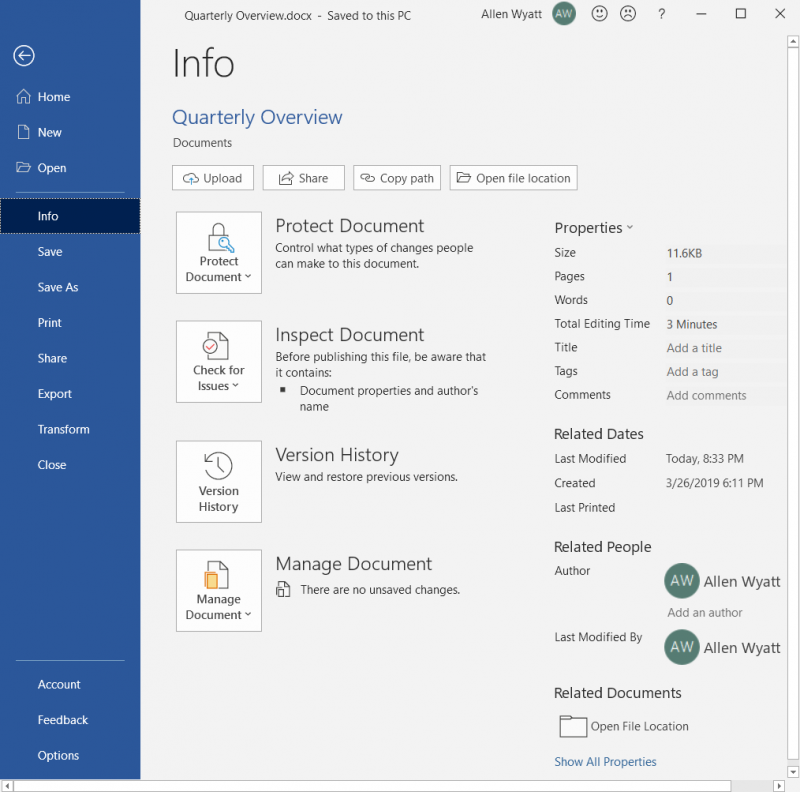Please Note: This article is written for users of the following Microsoft Word versions: 2007, 2010, 2013, 2016, 2019, 2021, and Word in Microsoft 365. If you are using an earlier version (Word 2003 or earlier), this tip may not work for you. For a version of this tip written specifically for earlier versions of Word, click here: Controlling Document Properties.
Written by Allen Wyatt (last updated March 12, 2022)
This tip applies to Word 2007, 2010, 2013, 2016, 2019, 2021, and Word in Microsoft 365
You may be aware that Word allows you to track and control quite a few properties relating to your document. Whenever you save a document to disk, Word appends the property information that is used to identify the file and its contents. These properties are also used by the file management utilities in Word and can be accessed by special Word fields.
If you want to change the document properties, you can do so using two interfaces: simple and advanced. How you display the simple interface depends on the version of Word you are using:
If you are using Word 2016 or a later version, the Document Panel is already visible under the Properties heading at the right side of the screen if Info is selected on the File tab of the ribbon. (See Figure 1.)

Figure 1. The Info section of the File tab of the ribbon.
Regardless of your version, a panel of common document properties appears. You can use the controls in the panel to make changes to the properties. If you want to change the properties more extensively, then use these techniques:
Whenever you make changes to document properties, those changes are stored with the document itself. That means that any changes you make in one document's properties won't be reflected in a different document's properties.
WordTips is your source for cost-effective Microsoft Word training. (Microsoft Word is the most popular word processing software in the world.) This tip (7722) applies to Microsoft Word 2007, 2010, 2013, 2016, 2019, 2021, and Word in Microsoft 365. You can find a version of this tip for the older menu interface of Word here: Controlling Document Properties.

Learning Made Easy! Quickly teach yourself how to format, publish, and share your content using Word 2021 or Microsoft 365. With Step by Step, you set the pace, building and practicing the skills you need, just when you need them! Check out Microsoft Word Step by Step today!
When you save a file, the information from the start of the file is saved in the properties for the document and can be ...
Discover MoreWhat are you to do if you embed fonts in a document and then someone else cannot make changes to that document? Chances ...
Discover MoreWord maintains a collection of descriptive properties for each document you create. One of these properties is the Title ...
Discover MoreFREE SERVICE: Get tips like this every week in WordTips, a free productivity newsletter. Enter your address and click "Subscribe."
There are currently no comments for this tip. (Be the first to leave your comment—just use the simple form above!)
Got a version of Word that uses the ribbon interface (Word 2007 or later)? This site is for you! If you use an earlier version of Word, visit our WordTips site focusing on the menu interface.
Visit the WordTips channel on YouTube
FREE SERVICE: Get tips like this every week in WordTips, a free productivity newsletter. Enter your address and click "Subscribe."
Copyright © 2026 Sharon Parq Associates, Inc.
Comments